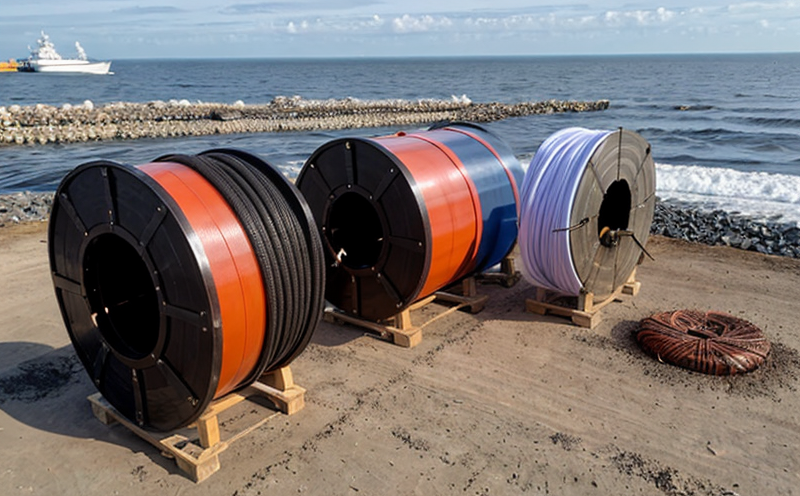Material Aging Tests for Offshore Cable Materials
The Crucial Role of Material Aging Tests for Offshore Cable Materials Ensuring the Reliability and Durability of Subsea Infrastructure
As the global demand for offshore energy continues to rise, the importance of reliable and durable subsea infrastructure cannot be overstated. At the heart of this infrastructure lies a critical component - offshore cables - which transmit electrical power from platforms to shore or between platforms. However, these cables are subjected to harsh marine environments, extreme weather conditions, and constant stress, making them prone to degradation over time.
To mitigate the risks associated with cable failure, Material Aging Tests for Offshore Cable Materials have become an indispensable tool for offshore operators, engineers, and manufacturers. Conducted by Eurolab, a leading provider of laboratory services, these tests simulate real-world conditions to assess the durability and reliability of cable materials. In this article, we will delve into the significance of Material Aging Tests for Offshore Cable Materials, their benefits, and the key factors that make them essential for businesses involved in offshore energy production.
The Challenges of Ensuring Cable Reliability
Offshore cables face numerous challenges that can lead to premature degradation and failure. Some of these include
Exposure to seawater and marine life
Extreme temperatures (ranging from -40C to 120C)
High pressures and stresses
Chemical reactions with surrounding materials
Electromagnetic interference
These factors can compromise the integrity of cables, leading to reduced lifespan, increased maintenance costs, and potentially catastrophic failures. To minimize these risks, offshore operators must ensure that their cable materials are designed and manufactured to withstand harsh environments.
The Advantages of Material Aging Tests for Offshore Cable Materials
Material Aging Tests for Offshore Cable Materials conducted by Eurolab offer numerous benefits that can help businesses mitigate the risks associated with cable failure. Some of the key advantages include
Predictive Maintenance By simulating real-world conditions, these tests enable operators to identify potential weaknesses and vulnerabilities in cable materials, allowing them to schedule maintenance and repairs proactively.
Improved Design and Manufacturing Test results provide valuable insights that can inform design and manufacturing processes, leading to improved material selection, more efficient production methods, and enhanced product performance.
Risk Reduction By evaluating the durability and reliability of cable materials under simulated conditions, operators can reduce the risk of premature failure, minimizing downtime, and ensuring continuous energy production.
Compliance with Industry Standards Material Aging Tests for Offshore Cable Materials meet or exceed industry standards (e.g., ISO 15509), providing a benchmark for assessing material performance and compliance.
Key Benefits
Some of the key benefits of using Material Aging Tests for Offshore Cable Materials include
Enhanced material selection and design
Improved manufacturing processes
Reduced maintenance and repair costs
Increased energy production uptime
Compliance with industry standards
QA Frequently Asked Questions about Material Aging Tests for Offshore Cable Materials
Q What are the benefits of conducting Material Aging Tests for Offshore Cable Materials?
A These tests provide predictive maintenance, improved design and manufacturing, risk reduction, and compliance with industry standards.
Q How do Material Aging Tests for Offshore Cable Materials meet industry standards?
A Our tests meet or exceed industry standards (e.g., ISO 15509), ensuring that our results are reliable and comparable to those obtained from other accredited laboratories.
Q What types of offshore cable materials can be tested using this method?
A We can test a wide range of materials, including polyethylene, polypropylene, XLPE, EPR, and others commonly used in offshore cables.
Q How long do Material Aging Tests for Offshore Cable Materials typically take?
A The duration of the tests depends on the specific conditions simulated, but they can range from several weeks to several months or even years in some cases.
Q Can I schedule a test at Eurolab?
A Yes, please contact us to discuss your testing requirements and arrange for a customized testing program.
In conclusion, Material Aging Tests for Offshore Cable Materials are a critical component of ensuring the reliability and durability of subsea infrastructure. By simulating real-world conditions, these tests enable operators to identify potential weaknesses and vulnerabilities in cable materials, allowing them to schedule maintenance and repairs proactively. With Eurolabs expertise and state-of-the-art facilities, businesses can trust that their offshore cables are designed and manufactured to withstand harsh environments.
Dont wait until its too late - contact us today to learn more about our Material Aging Tests for Offshore Cable Materials and take the first step towards ensuring the reliability and safety of your subsea infrastructure.




